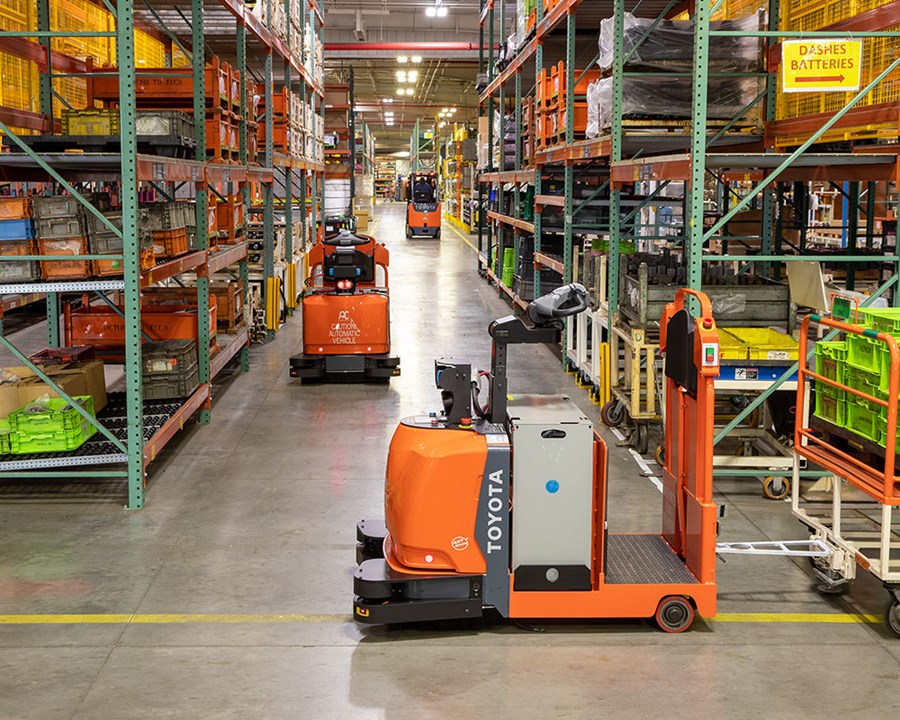
Autonomous Vehicles: Bringing Flexibility to Indian Warehouse Operations
Manjunath D | 9 August 2022
Autonomous vehicles such as AGVs (automated guided vehicles) and AMRs (autonomous mobile robots) are self-guided load carriers that can autonomously travel to execute tasks assigned to them and can be the best fit for distribution centres, warehouses or manufacturing facilities. These vehicles can work independently without an onboard operator due to the latest innovation in sensors and control devices that help drive the navigation.
In the newest phase of industrial revolution or Industry 4.0, companies can initiate a collaborative culture with autonomous vehicle integration to enhance productivity and profitability and to ensure an operating environment with better safety, optimal workforce and a better outcome. The industrial revolution indeed brings much more opportunity to the manufacturers operating in the AGV and AMR market globally and also for India, enhancing the reach of this market.
Before the pandemic in 2019, the India AGV market alone was valued at $122.1 million. AGV and AMR technology installations were limited in the Indian market due to high initial investment costs and a lack of awareness. However, with the boom of Industry 4.0 and the changes in demand and supply chain challenges means automation has become a business necessity. This new paradigm has become a driver for AGV and AMR market resulting in increased innovations to meet needed application and technological expectations.
Let’s look at some of those market drivers, and key technical and operational details to find the best fit for warehouse operations.
Market Drivers for Autonomous Vehicles
Though AGVs had the upper hand at the start of initial interest in autonomous vehicles, now AMRs are gradually increasing the market share due to their ability to adapt and improvise their path on the go, saving time.
The AGV and AMR market is expected to achieve a value of around $18 billion by 2027, with potential growth of around 24% for the AGV market and 43% [CAGR] for the AMR market. Also, the collective installation base for AGVs and AMRs is anticipated to be 2.4 million by 2027.
The AGV and AMR market growth extends to the technology and innovations in the sector, which is application driven.
Finding the Best Fit for Warehouse Operations
It has become critical for companies to choose the technology or solutions which are the best fit for the intended facility. Also, it’s key to consider the high initial CapEx (capital expenditure), it is vital to analyse the potential return on investment and business requirements (like throughput rates) against a sustained roadmap for growth.
Further, while choosing the technology or selecting an AGV or AMR, it is crucial to consider:
- product profiles
- throughput details
- order details
- inventory snapshots
- application factor
With a high customer demand drive and existing competitive market, optimization of warehouse operations is necessary to sustain the business with the best ROI and continual business growth. This necessity creates a need for AGV and AMR, which play as a facilitator in optimizing the space in current warehouses and facilities. It will also reduce the need for expansion to costly fulfilment or distribution centres to ensure that the throughput is met, and all the orders are fulfilled on time.
Technical Walkthrough
When it comes to AGVs and AMRs, AGVs follow a fixed path. AMRs on the other hand follow a dynamic path and can freely navigate through the surrounding in which its deployed. Due to the same reason, AGVs would be perfect if the application involves repetitive tasks. They would be much more productive if deployed in an area with fewer manual movements and fewer machinery. AMRs would work effectively even in a facility with high manual interference as it could re-route its active path if it met any obstacle.
Compared to the commercial part, AGVs are comparatively much more financially economical than AMRs as AGVs use simple sensor and control devices in order to follow a fixed path. In the case of AMRs, in order for it to navigate more freely, it requires a much more innovative control system.
In recent years, innovations have been happening in all sectors, like navigation for AGVs. Some commonly used AGV navigation methods are magnetic or magnetic spot navigation, barcode or QR code based, RFID based, or wire and optical system-based navigation. In the case of AMR, it creates and saves the location or map of the facility and would help AMRs find alternative paths when the active path is blocked. LiDAR (Light Detection and Ranging) and sensor fusion methods are the critical navigation technologies followed mostly in AMRs.
Regarding standards, AGVs follow ITSDF B56.5 safety, whereas AMRs follow a much more sophisticated ANSI/RIA safety standard which helps AMRs operate with improved safety features.
Achieve a Competitive Edge
It is always important to think ahead. In a rapidly growing and high demand-driven economy, there is an opportunity to harness new innovations and gain a competitive edge. This is where autonomous vehicles like AGVs and AMRs could bring flexibility to Indian warehouse operations and market. Ensure better productivity, optimize operations and achieve high ROI over a short period.
Talk to a solutions expert today and visit us at the India Warehousing Show August 19 - 21 at Booth D17.
Mr. Manjunath D is the Senior Manager for Controls & Automation for Bastian Solutions supporting the India region. He has a degree in electrical and electronics engineering. He has been integral part of Indian team for more than the past 10 years and brings with him more than 20 years of experience in control systems, controls solution delivery and automation solutions.
Comments
No comments have been posted to this Blog Post
Leave a Reply
Your email address will not be published.
Comment
Thank you for your comment.